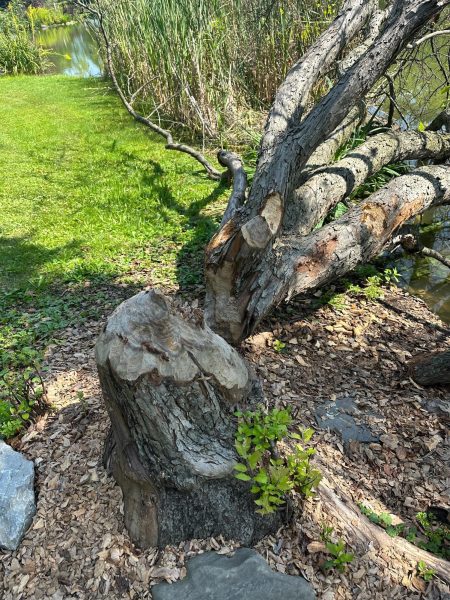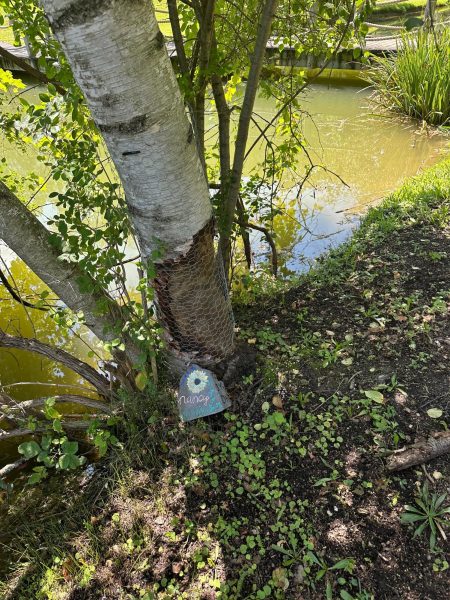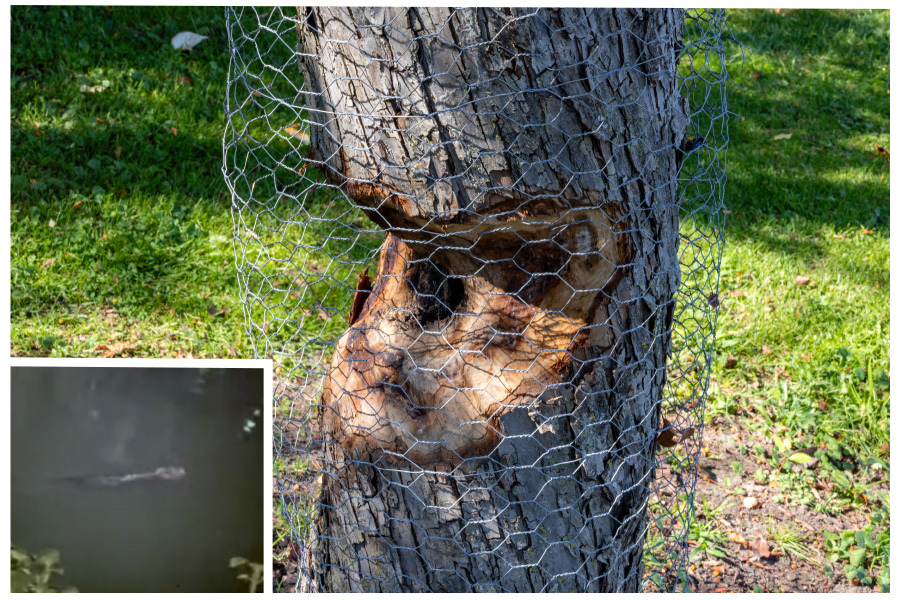Ithaca College, an environmentally-friendly campus featuring several acres of natural lands, faces a destructive creature simply trying to find a home. A beaver has moved into the pond behind Muller Chapel and has two options: eviction or death. The relaxing environment of the pond behind Muller Chapel now showcases fallen trees and torn brush encircled by wire.
Brenda Wickes, assistant director in the Office of Student Accessibility Services, noticed this destruction Aug. 29 on her typical walk around the Muller Chapel pond.
“I thought it was really cool but also problematic,” Wickes said. “I just noticed the tree that was down. [I] looked at it, and it was obvious to me — having grown up in Upstate New York — that it was a beaver cut.”
The college is no stranger to wild animals making their way up to South Hill. Deer, geese and other creatures native to Ithaca have found a home on campus. Leann Kanda, associate professor in the Department of Biology and member of the college’s Natural Lands Committee, said nuisance animals often attempt to room with students in residential buildings.
“This is the first beaver I know of at least in the last decade,” Kanda said. “We’ve certainly had muskrats and nuisance animals that are always trying to live in our buildings. … I’ve known rooms in the Terraces that have a flying squirrel that just kept coming back.”
Kanda said a beaver making its way to the college is not abnormal either.
“This was probably a young animal that was dispersing from where it grew up,” Kanda said. “This is a pattern. Just like us, they grow up at home, then they go off and make their own way in the world.”
Beavers’ infamous nature to build dams and shelters from fallen trees has deemed them nuisance animals by the New York State Department of Environmental Conservation. The need to alter the landscape around them, Kanda said, is what makes them so troublesome to institutions like the college that are trying to maintain a peaceful nature reserve.
“Beavers really manipulate the landscape. Known as ecosystem engineers, they physically alter the environment around them to make it a better beaver habitat,” Kanda said. “So unfortunately, a beaver’s idea of a good habitat and a human’s idea of a good habitat rarely coincide. … We both are actively manipulating the environment to be the way we want and we both have different ideas.”

Despite there being only one, deterring the animal has not proven an easy task because beavers are most active at night and this one is evading sight. Ernie McClatchie, associate vice president of the Office of Facilities, said this beaver’s tendency to appear and reappear has been ongoing since the summer.
“It was here back in May, went away, we thought it was gone. There were no signs of it, then it reappeared,” McClatchie said. “It probably reappeared in the middle of summer. We were actively working on removing it, then it disappeared again and now it’s been back for a few weeks”
A beaver tends to wander among environments before choosing one to settle, so dealing with the animal immediately has not been a priority for the Office of Facilities. However, McClatchie said this beaver has been more stubborn to leave than is usual.
“Normally if you do see one early, you kinda give it a few days or something and it moves on,” McClatchie said. “This one was interesting. It wasn’t moving on. It was trying to take up residence here.”
The DEC controls all regulation of protected species designated mammals in New York state. Depending on the species of protected animal, before action is taken, a permit must be obtained or a DEC officer must be notified first. As the beaver is New York’s official state mammal and was nearly extinct in the 1800s, it is considered a protected animal.
Mandy Watson, a wildlife biologist with the New York DEC, said beavers are in good population standing by DEC regulation.
“They are protected as a game species, so there is a regulated harvest season but can only be [hunted] during that period of time,” Watson said. “What we’ve seen is that the number of reports [of nuisance beavers] overall has been going up throughout the years and beavers have pretty well saturated most of the ideal habitat in New York, so we definitely have a robust beaver population.”
The DEC Beaver Damage Control Techniques Manual, published in 1996, states that relocations can occur under “extraordinary” exceptions. They are not endangered as of 2016 and are currently flourishing in New York. Watson said relocation is not allowed anymore because of a high beaver population of 55,000–70,000.
“That manual is quite dated. That is something we’re working on updating,” Watson said. “These days, the [extraordinary] situations are something we wouldn’t allow.”
Trapping or killing an animal like the beaver is only suggested by the DEC if other practices do not control the problem.
“Relocations are difficult and not because it’s hard to stick the animal in a trap.” Kanda said. “You’re taking this animal, stressing it horribly, dropping it into a completely unfamiliar environment — which if it is a suitable habitat, it is already occupied by someone else. … Straight out killing them humanely at the outset may be the more ethical approach in most cases.”
The Office of Facilities has tried to deter this beaver with fencing around trees and by disturbing its den but is having trouble producing results. McClatchie said he prefers forcing the beaver out and killing the beaver only when other options have failed. As of Sept. 14, the office has not opted to kill the beaver although a permit has been obtained to do so.
There is always the option of allowing the animal to coexist with the campus community. However, Watson said this is unlikely.
“It’s not unusual for landowners to appreciate having a beaver on the property due to the habitat they create,” Watson said. “If they have a lot of land, it’s not as big of an issue compared to a campus where you do have a lot more people.”
The Office of Facilities finds the damage to the environment too great, making removing the beaver a necessity. Damage to the Muller Chapel area aesthetically and environmentally is assured and beavers are not accommodating to memorial trees planted around the pond.

McClatchie said coexistence with the beaver is not possible because of the damage and because the pond is not sustainable for the beaver.
“We keep monitoring to ensure it’s not blocking the outlet of the pond,” McClatchie said. “More than anything that is my biggest concern. If he was to dam that up and we had a large rain event, we’d have to be using overflow.”
The law may be strict, but Kanda said the grim-sounding sentencing of the beaver is the most humane option.
“It becomes, ‘What is the most humane thing we can do with this animal?’ because this is not a space where it can live,” Kanda said. “There are a lot of students that may get up in arms saying, ‘Oh my god you’re killing the cute animal!’ … Often what happens to relocated animals is that they become a nuisance to another land owner. You haven’t solved the problem, you just made it someone else’s.”
The Office of Facilities’ patience for deterrence grows weary with every tree that falls and every branch that breaks by the paws of this beaver. Wickes, who is looking to continue her peaceful walks around the pond, said there is great irony in removing the beaver.
“Those species were here before IC was built and the descendants are still here, and they will be here after,” Wickes said.














